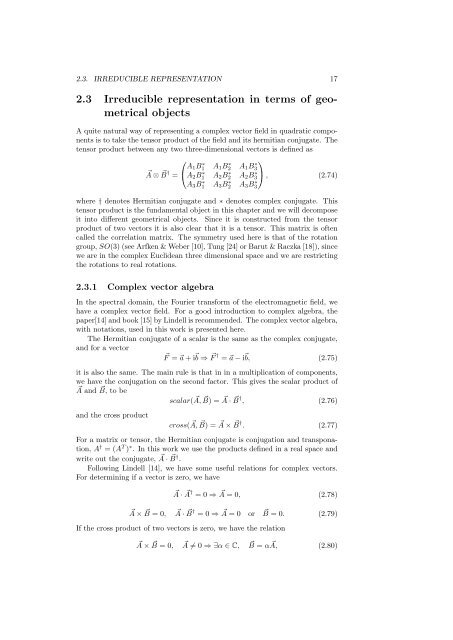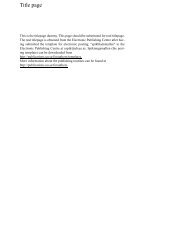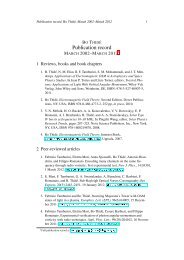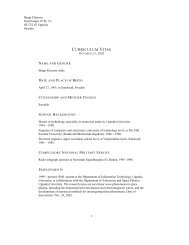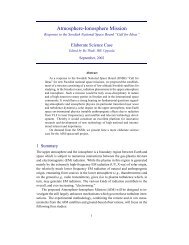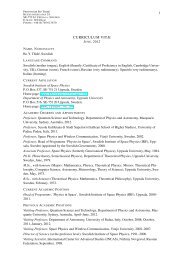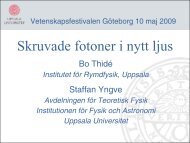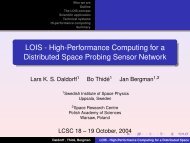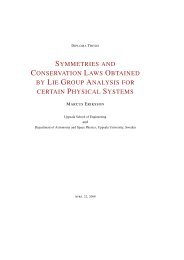Towards a covariant formulation of electromagnetic wave polarization
Towards a covariant formulation of electromagnetic wave polarization
Towards a covariant formulation of electromagnetic wave polarization
You also want an ePaper? Increase the reach of your titles
YUMPU automatically turns print PDFs into web optimized ePapers that Google loves.
2.3. IRREDUCIBLE REPRESENTATION 17<br />
2.3 Irreducible representation in terms <strong>of</strong> geometrical<br />
objects<br />
A quite natural way <strong>of</strong> representing a complex vector field in quadratic components<br />
is to take the tensor product <strong>of</strong> the field and its hermitian conjugate. The<br />
tensor product between any two three-dimensional vectors is defined as<br />
⎛<br />
⃗A ⊗ B ⃗ † = ⎝ A ⎞<br />
1B1 ∗ A 1 B2 ∗ A 1 B3<br />
∗<br />
A 2 B1 ∗ A 2 B2 ∗ A 2 B3<br />
∗ ⎠ , (2.74)<br />
A 3 B1 ∗ A 3 B2 ∗ A 3 B3<br />
∗<br />
where † denotes Hermitian conjugate and ∗ denotes complex conjugate. This<br />
tensor product is the fundamental object in this chapter and we will decompose<br />
it into different geometrical objects. Since it is constructed from the tensor<br />
product <strong>of</strong> two vectors it is also clear that it is a tensor. This matrix is <strong>of</strong>ten<br />
called the correlation matrix. The symmetry used here is that <strong>of</strong> the rotation<br />
group, SO(3) (see Arfken & Weber [10], Tung [24] or Barut & Raczka [18]), since<br />
we are in the complex Euclidean three dimensional space and we are restricting<br />
the rotations to real rotations.<br />
2.3.1 Complex vector algebra<br />
In the spectral domain, the Fourier transform <strong>of</strong> the <strong>electromagnetic</strong> field, we<br />
have a complex vector field. For a good introduction to complex algebra, the<br />
paper[14] and book [15] by Lindell is recommended. The complex vector algebra,<br />
with notations, used in this work is presented here.<br />
The Hermitian conjugate <strong>of</strong> a scalar is the same as the complex conjugate,<br />
and for a vector<br />
⃗F = ⃗a + i ⃗ b ⇒ ⃗ F † = ⃗a − i ⃗ b, (2.75)<br />
it is also the same. The main rule is that in in a multiplication <strong>of</strong> components,<br />
we have the conjugation on the second factor. This gives the scalar product <strong>of</strong><br />
⃗A and ⃗ B, to be<br />
scalar( ⃗ A, ⃗ B) = ⃗ A · ⃗B † , (2.76)<br />
and the cross product<br />
cross( ⃗ A, ⃗ B) = ⃗ A × ⃗ B † . (2.77)<br />
For a matrix or tensor, the Hermitian conjugate is conjugation and transponation,<br />
A † = (A T ) ∗ . In this work we use the products defined in a real space and<br />
write out the conjugate, ⃗ A · ⃗B † .<br />
Following Lindell [14], we have some useful relations for complex vectors.<br />
For determining if a vector is zero, we have<br />
⃗A · ⃗A † = 0 ⇒ ⃗ A = 0, (2.78)<br />
⃗A × ⃗ B = 0, ⃗ A · ⃗ B † = 0 ⇒ ⃗ A = 0 or ⃗ B = 0. (2.79)<br />
If the cross product <strong>of</strong> two vectors is zero, we have the relation<br />
⃗A × ⃗ B = 0, ⃗ A ≠ 0 ⇒ ∃α ∈ C, ⃗ B = α ⃗ A, (2.80)


